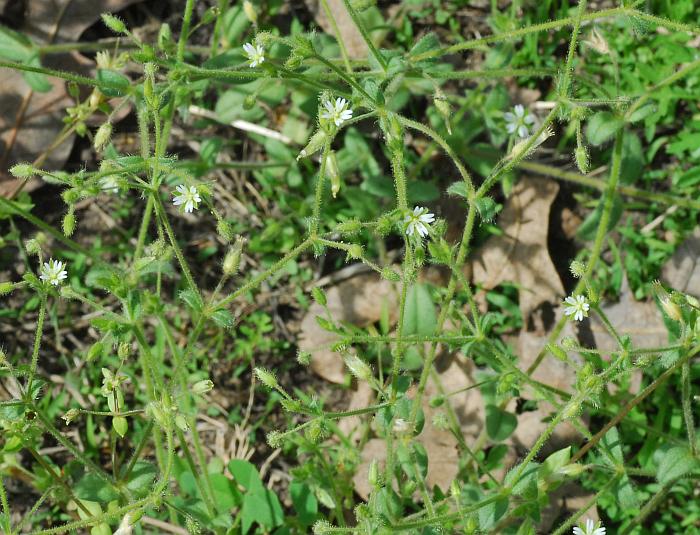Cerastium brachypetalum Pers.
Gray Mouse-Ear Chickweed

Introduced
CC = *
CW = 5
MOC = 17
© SRTurner
Cerastium brachypetalum Pers.Gray Mouse-Ear Chickweed | |
 |
Introduced CC = * CW = 5 MOC = 17 |
© SRTurner |
|
Family - Caryophyllaceae Habit - Annual forb. Stems - Ascending to erect, to 35 cm, usually branched toward the tip, pubescent with long, silvery hairs, these sometimes mixed with or replaced by glandular hairs toward the tip.
Leaves - Opposite, simple, entire, sessile, lacking axillary clusters of leaves. Leaf blades 0.5-2.5 cm long, spatulate (some basal leaves) or elliptic to ovate, angled to a bluntly or sharply pointed tip.
Inflorescence - Flowers in open panicles, the stalks 0.6-1.6 cm long, these usually 2-3 times as long as the sepals, erect or spreading, at fruiting sometimes appearing hooked near the tip, densely pubescent with glandular hairs, the bracts with herbaceous, green margins.
Flowers - Sepals 5, 3-5 mm long, lanceolate, green, usually with membranous margins, angled to a bluntly or sharply pointed tip, densely pubescent with nonglandular and sometimes also glandular hairs, these extending past and somewhat obscuring the sepal tips. Petals 5, 2.0-3.5 mm long, about 2/3-3/4 as long as the sepals, shallowly 2-lobed at the tip, the veins usually not apparent. Stamens 10. Styles 5.
Fruits - Cylindrical capsules, 6.0-8.5 mm long, about 1.5 times as long as the sepals, slightly curved. Seeds 0.4-0.5 mm wide, the surface tuberculate, light brown.
Flowering - March - May. Habitat - Lawns, fields, pastures, roadsides, railroads, glades, prairies. Origin - Native to Europe. Lookalikes - Several other species of Cerastium, and to a lesser extent, Stellaria. Differentiation requires attention to fine details. Other info. - To judge from collection data, this species is less common in Missouri than some other members of the genus. Currently, the majority of collections are from the southwestern portion of the state, with a few sprinkled records in the east. The U.S. distribution is similarly scattered and sporadic, mostly in the southeastern quadrant of the country. Since the plant is weedy in appearance and generally inconspicuous, it may be substantially undercollected. The species is recognized by long, silvery hairs on many parts of the plants, inflorescence bracts which are entirely green, and the open, uncrowded inflorescences. When growing in sunny areas, the plant typically has a distinct grayish appearance. In shady areas, the grayish appearance is mostly absent.
Photographs taken off Lee Rd 10, Lee County, AL., 3-20-06 and 3-22-06 (DETenaglia); also at Danville Conservation Area, Montgomery County, MO, 5-8-2018, and Otter Slough Conservation Area, Stoddard County, MO, 4-22-2019 (SRTurner). |